- What’s the difference between pluots and plumcots? By the guy who wrote the book.
- ACIAR publication on village chickens, and another. Thanks, DAD-Net.
- Modeling the axolotl, the edible Mexican salamander, before it’s too late.
- Artisanal fishing data. Via.
- USDA looking to expand its fruit collection to cope with climate change. NOt the only ones, I imagine.
- Danes stamp on allotments. No, wait. Allotments on Danish stamps.
- Aussies find genetic marker for hornless cattle that will jump on barbie by themselves.
- Breeding better Artemisia annua.
- The diversity of farmer-managed aquatic systems in SE Asia.
- 15% of angiosperm speciation events are accompanied by ploidy increase. Much more in domesticated species, I bet.
Snorkel rice
![]() Yoko Hattori and colleagues report in Nature 1 that they have identified two genes involved in the awesome elongation of deep water rice; the type of rice that can grow in several meters deep water. The genes, baptized SNORKEL1 and SNORKEL2, can now be identified with molecular markers and crossed into popular rice varieties. The BBC has a nice video comparing — I assume — genetically otherwise nearly identical rice varieties with and without the genes.
Yoko Hattori and colleagues report in Nature 1 that they have identified two genes involved in the awesome elongation of deep water rice; the type of rice that can grow in several meters deep water. The genes, baptized SNORKEL1 and SNORKEL2, can now be identified with molecular markers and crossed into popular rice varieties. The BBC has a nice video comparing — I assume — genetically otherwise nearly identical rice varieties with and without the genes.
The avid reader will remember the runner-up entry in The Competion about the sub-1 gene 2, that is used by IRRI to make rice flood-proof. Some of these new sub-1 varieties, such as Swarna-sub1 are already grown by farmers in India and Bangladesh.
Interestingly, sub-1 does the very opposite of SNORKEL. Sub-1 shuts the plant off to stop elongation, so that it saves its energy, and can recover later. This works great with flash floods if the water recedes after a week or two. But if the water stays for longer than that, the crop dies. With stagnant deep water, a variety with the SNORKEL gene could be a better bet.
If farmers know beforehand that the water is going to be very deep (because it happens most years), they probably already plant deep water varieties (or plant later or do some other smart thing). Deep water rice is somewhat in decline, because of low yield, but it is grown on a very large area, probably about 3.5 million ha worldwide, mostly in India, Bangladesh, Myanmar, Thailand, Indonesia, Vietnam and Cambodia.
However, if flooding is rare it could be more profitable, though risky, to plant other than deep-water varieties. For their earliness, yield, quality, or what not. Adding either the sub-1 or the SNORKEL gene 3 to those varieties would be an insurance policy for flood years. But which gene to choose? And in what variety? And where to grow it? Not an easy question, but we have been trying to answer it.
Mapping Argentinian pests and diseases
The Instituto Nacional de Tecnología Agropecuaria in Argentina has a new online pest and disease atlas out. It’s in Spanish, but pretty intuitive to use. You can search by host or by pest/disease organism. And you get a bunch of references, descriptive notes, photos and a map, albeit a static one — not sure how updating will be done. Below is the distribution of Setosphaeria turcica, the causal agent of Northern Leaf Blight in corn, for example. Would be interesting to mash this kind of thing up with the distribution of tolerant material. Must look into that. And of course one could do some climate change prediction modeling too. Thanks to IIALD.
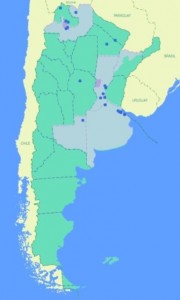
No little houses on this prairie
I promised you more on the Doolittle Prairie, and here it is. But first, thanks to Candy Gardner for arranging the visit, and to Mark Widrlechner for leading the tour.
Doolittle Prairie State Preserve, near Story City in Iowa, is a small remnant of native tallgrass prairie. The 26-acre state-owned protected area supports about 220 plant species. 4 About half of the area, the northern part, has never been ploughed or grazed, though hay was cut until the 60s. The southern part has been grazed, and the southwest corner ploughed until 1965 and then replanted with seed from the northern section. All around are fields of maize and soybean. Management is by cutting and burning, to keep down exotics, and encroaching shrubs and trees.
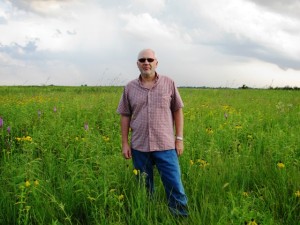
It’s a very evocative place. You can just imagine the deer and the buffalo roaming on it back in the day. There are still deer. Buffalo, not so much. 5 It’s also pretty interesting from an agrobiodiversity perspective, because it’s got quite a number of crop wild relatives for such a small place.
A couple of species of wild sunflowers, for example. This one is Helianthus rigidus:
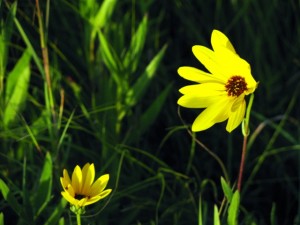
There are also native species of Allium, Elymus, Lactuca, Fragaria, Prunus, Ribes, Rubus, and Vitis:
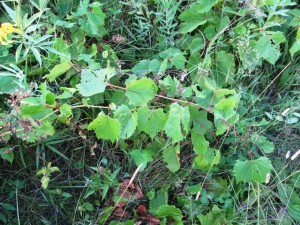
All in a beautifully colorful setting, at least at this time of the year.
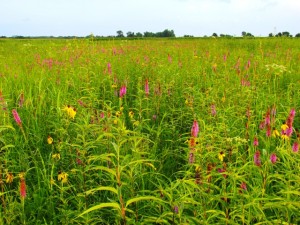
So, a bit of a CWR hotspot, in its own small way, and protected to boot. You may remember the recent global review of the role of protected areas in CWR conservation. I don’t think that CWR have been mapped in the US in the same way as has been done in Russia, however. 6 Once you have geo-referenced CWR locations, you could easily mash the result up with the online map of protected areas to see which national parks and reserves contribute most to CWR conservation. Anybody out there working on this? I bet little Doolittle Prairie would be on that list.
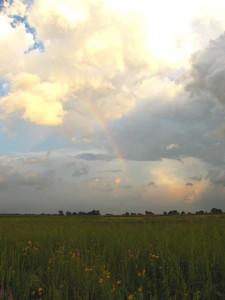
“We have very little data”
That’s Javier de la Torre talking about ecological niche modeling at GeoWeb. Well, I would qualify that by saying we have too little digitized data. Certainly for many crop wild relatives, for example. Javier was involved in a recent online mashup of the global protected area database. His GeoWeb slides are below, catch his talk on YouTube.